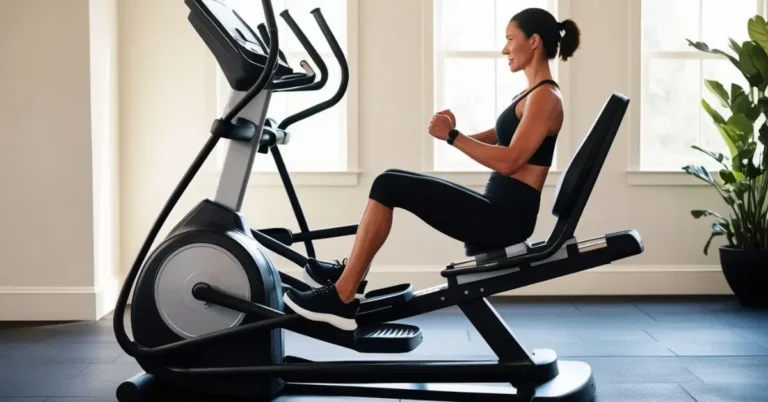The elliptical machine, a staple in gyms and home workout spaces, has become a popular choice for people seeking low-impact cardiovascular exercise. Its design and functionality allow for a full-body workout that is gentle on the joints while effectively burning calories, improving cardiovascular health, and building strength. Over the years, the elliptical has evolved, with various models catering to different fitness needs, making it one of the most versatile pieces of exercise equipment available today.
This article delves into the elliptical machine’s history, its mechanics, the numerous benefits it offers, and tips for maximizing workouts. Additionally, we will explore how the elliptical compares to other cardio machines like treadmills and stationary bikes, and why it continues to be a favorite for many fitness enthusiasts.
The History and Evolution of the Elliptical Machine
The elliptical machine was first introduced to the fitness market in the mid-1990s, and it quickly gained popularity due to its unique ability to simulate walking, running, and stair climbing without the harsh impact on joints associated with these activities. Precor, a leading fitness equipment manufacturer, is credited with creating the first elliptical trainer. The idea was to offer a machine that provided the cardiovascular benefits of running but minimized the risk of injury, particularly to the knees, hips, and lower back.
As the demand for low-impact exercise equipment grew, other manufacturers began producing their versions of the elliptical. Over time, these machines incorporated more advanced features, such as adjustable inclines, heart rate monitors, and pre-programmed workouts. Today, ellipticals come in various forms, including compact home models, elliptical cross-trainers, and hybrid machines that combine the features of ellipticals with other types of cardio equipment, such as stationary bikes.
How the Elliptical Machine Works
The elliptical machine is designed to mimic natural body movements, allowing the user to move their legs in an oval, or elliptical, pattern. This motion is smoother and less jarring than running or walking on a treadmill. The machine typically features two large pedals where users place their feet and handles they can hold onto, which move in sync with the pedals. As the user pushes the pedals forward and backward, the handles move in coordination, engaging both the upper and lower body muscles.
One of the key aspects of the elliptical is its ability to offer a weight-bearing exercise, which is essential for bone health, without causing excessive strain on the joints. The elliptical movement engages several major muscle groups simultaneously, including the quadriceps, hamstrings, glutes, calves, and core. Additionally, when the handles are used, the upper body muscles, such as the biceps, triceps, chest, and shoulders, are activated as well.
Benefits of Using an Elliptical Machine
- Low-Impact Exercise
The most significant advantage of using an elliptical machine is its low-impact nature. Unlike running, which can place a considerable amount of stress on the joints, particularly the knees, an elliptical allows for smooth, controlled movement that reduces the risk of injury. This makes it an ideal option for people with joint problems, arthritis, or those recovering from injury. - Full-Body Workout
While many cardio machines primarily target the lower body, the elliptical machine engages both the upper and lower body simultaneously. By using the handles, you can work out your arms, shoulders, chest, and back, in addition to your legs. This results in a more balanced workout and helps burn more calories. - Improved Cardiovascular Health
Like other forms of cardio, using an elliptical helps to improve heart health by increasing your heart rate, improving circulation, and strengthening the cardiovascular system. Regular use can help reduce the risk of heart disease, lower blood pressure, and improve lung capacity. - Calorie Burning and Weight Loss
The elliptical is an effective calorie-burning machine. Depending on the intensity of the workout, users can burn between 300 to 600 calories per hour. When combined with a balanced diet, this can contribute to significant weight loss over time. - Strengthens Muscles and Improves Endurance
In addition to its cardiovascular benefits, the elliptical also helps build muscle strength, particularly in the lower body. By adjusting the resistance and incline settings, users can target specific muscle groups, such as the glutes, hamstrings, and calves. The elliptical can also be used to improve endurance, making it a valuable tool for athletes or anyone looking to enhance their overall fitness level. - Joint and Bone Health
Because the elliptical is a weight-bearing exercise, it promotes bone density, which is crucial in preventing osteoporosis and maintaining healthy bones as we age. It also helps to improve joint mobility without putting unnecessary strain on the joints. - Versatility and Customization
Most elliptical machines come with various features that allow users to customize their workouts based on their fitness goals. Adjustable resistance, incline settings, and pre-programmed workout routines can cater to different fitness levels, whether you are a beginner or an advanced athlete. This versatility makes the elliptical suitable for a wide range of users.
Comparing the Elliptical to Other Cardio Machines
When deciding between different cardio machines, such as the treadmill, stationary bike, or rowing machine, it’s important to consider your fitness goals and any physical limitations you may have. Here’s how the elliptical stacks up against other popular cardio equipment:
- Elliptical vs. Treadmill
The treadmill is often considered the go-to machine for runners and walkers. However, the high-impact nature of running on a treadmill can be hard on the joints, particularly the knees, hips, and lower back. The elliptical offers a much gentler, low-impact workout while still providing cardiovascular benefits and calorie burning. For individuals with joint pain or injuries, the elliptical is usually a better option. - Elliptical vs. Stationary Bike
Both the elliptical and stationary bike provide low-impact workouts, but the elliptical engages more muscle groups, including the upper body. While the stationary bike primarily targets the lower body, the elliptical offers a full-body workout. In terms of calorie burning, the elliptical typically burns more calories than a stationary bike, making it a more efficient choice for weight loss. - Elliptical vs. Rowing Machine
The rowing machine, like the elliptical, provides a full-body workout. However, the movement of rowing is very different, focusing more on pulling and core strength. Rowing machines are excellent for building muscle endurance and cardiovascular health but may not be as accessible to beginners as ellipticals due to the technique required. Ellipticals are easier to use and often more appealing for those seeking low-impact cardio.
Tips for Maximizing Your Elliptical Workout
- Use Proper Form
To avoid injury and ensure you are getting the most out of your workout, it is essential to maintain proper form on the elliptical. Stand upright with your back straight, engage your core, and avoid leaning too heavily on the handles. Keep your shoulders relaxed and your head up. - Incorporate Interval Training
Interval training involves alternating between periods of high-intensity exercise and low-intensity recovery. On the elliptical, this can be done by increasing the resistance or incline for short bursts, followed by a period of lower intensity. Interval training is a great way to boost calorie burning and improve cardiovascular fitness. - Focus on Both Forward and Backward Motion
Most people use the elliptical in a forward motion, but you can also pedal backward to target different muscle groups. Pedaling backward places more emphasis on the hamstrings and calves, providing a more balanced lower-body workout. - Adjust the Resistance and Incline
To continuously challenge your muscles and avoid workout plateaus, regularly adjust the resistance and incline settings on the elliptical. Higher resistance levels will engage your muscles more, while increasing the incline will target your glutes and thighs. - Incorporate Upper Body Movements
If your elliptical has handles, be sure to engage your arms during the workout. Push and pull with your arms to activate your biceps, triceps, chest, and back. If your machine does not have moving handles, you can hold free weights or perform arm exercises while pedaling to work your upper body. - Track Your Progress
Most modern ellipticals come with digital displays that track your time, distance, calories burned, and heart rate. Use these features to monitor your progress and set specific fitness goals. Many machines also offer pre-programmed workouts or allow you to create custom workouts based on your fitness level.
Conclusion
The elliptical machine offers an exceptional blend of cardio, strength, and flexibility training in one low-impact workout. Its ability to target both the upper and lower body simultaneously makes it a highly effective tool for anyone looking to improve their fitness. Whether you’re a beginner or a seasoned athlete, the elliptical can be tailored to meet your fitness goals, from weight loss to muscle building and endurance training.
With proper form, varied workouts, and consistent use, the elliptical can provide a fun and challenging way to stay fit, improve cardiovascular health, and enhance overall physical well-being. Whether you’re recovering from an injury or simply looking for a joint-friendly alternative to running, the elliptical machine remains a top choice in the world of fitness equipment.

